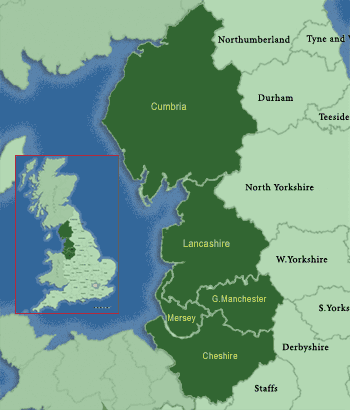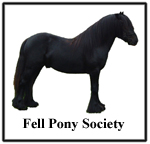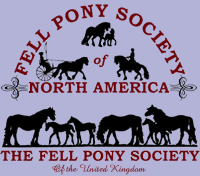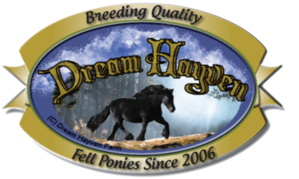The Fell Pony is a rare breed that originates from England, specifically, the
Cumbrian region, which is the northernmost county just under Scotland (see map)
It is here they are found in the greatest numbers, throughout history and today.
Fell Ponies are incredibly versatile, able to accomplish nearly anything! Perfect
on trails, popular in dressage, historically one of the best breeds you can find to
put to a carriage, easily able to jump much higher than their height would suggest,
intuitively very responsive to natural horsemanship techniques, competitive to
the highest level in obstacle work...the list goes on. In fact, a Fell Pony will be happiest doing a multitude of activities with you!
Fells have a maximum allowable height of 14 HH. Their build and structure allows them to carry most adult riders easily. Their shorter stature means they are very easy to work around, from a practical standpoint.
Except for the hardest working ponies, they are easy keepers, especially in a typical recreational home. They require less feed than a regular size horse, and usually do best on a diet of grass hay alone, with a vitamin and mineral balancer for good measure.
I have said often that "I originally bought Fell Ponies because of the way they look, but I chose to breed Fells because of the way they think". Fells are very intelligent and are quick learners. They remember their lessons like no other breed. It is up to the trainer to teach them only good things! They are also one of the only breeds I've discovered that are truly looking for a partnership with their owners. This is why I rarely if ever have problems with vices such as herdbound, rearing, kicking or bucking. They just don't do it. They want to spend time with their people. To ensure Dream Hayven foals have this mentality, I am one of few breeders that give their breeding stock ponies a training and show background. This means wearing a saddle (or driving harness), properly rounded and accepting of a bit and bridle, and the biggest indicator of personality: leaving the farm and conducting themselves properly in public. Our dedication to this principle has earned us the top award in North America for five years running (2014, 2015, 2016, 2017, 2018) as the overall FPSNA Ambassador Pony.
After visiting England and being surrounded by the pony's natural environment, I have a true appreciation for what these ponies are about, why they move and think the way they do, and why they must continue to do so to remain true-to-type Fell ponies. The breed is considered endangered and the gene pool is small. I feel compelled to take part in their conservation.
The Fell is considered an endangered breed, due to a suppressed number of breeding age mares worldwide, placing them on the 'Watch List" of The American Livestock Breeds Conservancy in addition to the Rare Breeds Survival Trust 'At Risk' placement.
Fells are considered one of the 11 Native Pony Breeds, that is, native to the United Kingdom. Welsh ponies and Connemaras are other examples of the native pony family. Genetically, Fells Ponies are considered to be 'cousins' to the Gypsy Vanner, which is unsurprising as much anecdotal evidence claims Fell Ponies were commingled with that breed historically. Both breeds are from the same region in England, but the Fell has a significantly longer traceable history, by hundreds of years.
Fell Ponies are named after topography of the region they are from, the Cumbrian Fells. A fell is quite steep, nearly mountainous, with one of the most traditional ranges for semi-feral pony herds, the Howgill Fells, reaching a top height above sea level 0f 2, 218 feet. The word is of old Norse background, and translates to: hill pony (from the north of England).
Fell ponies are some of the hardiest equines around today, and are bred to be so. There are still a handful of herds in England still being raised in a semi-feral state, which Americans may relate to the wild Mustang herds. This means although they receive the basic care necessary for proper stewardship, they are otherwise left alone for large portions of the year out on the fell. The word Fell can describe the hill itself, and also their use as large common areas of agricultural land several breeders and farmers have legal right to use within exacting parameters.
In no way is the Fell Pony derived from or a mini version of another larger breed, the Friesian horse from Holland. This misconception was propagated going back twenty years here in America, as Fell Pony breeders at the time attempted to cash in on the better known and often times higher priced 'lookalike' breed. Our governing body, the Fell Pony Society, says it best with this disclaimer straight from their website:
"The Fell Pony Society has frequently been made aware, by FPS members in England, Europe and USA, of advertisements containing the term "Mini Friesian" with reference to Fell ponies. Our Overseas Branches also tell us that they have to correct the use of this term on a regular basis, when exhibiting Fell ponies to the general public. To make such comparisons deliberately in any advertisement is misleading both about the Fell pony and about any other breed that is compared to it.
The Fell Pony Society wishes to state that it strongly disapproves of the use of comparisons with other breeds to describe, promote or advertise the Fell. A Fell pony is a Fell pony, a strong, hardy, versatile, purebred English working pony, who should not be described as a mini version of any other breed.
For a longer discussion of the historical arguments about the Friesian comparison, please see the Fell Pony Museum web site, http://www.fellponymuseum.org.uk/fells/rom_dark/friesian.htm"
Near 85% of Fell Ponies are black, have long hair and feathers, and are a draft breed. But genetically they are completely different. I've owned both breeds, so I can give my biased opinion & answer by saying yes, some Fells may look similar to Friesians, but better! Fells were bred to be hardy, easy keepers. Most get by on grass hay. Fell Ponies have very low incidences of colic, laminitis, or lameness. The Fell is not a hothouse flower! The Fell is much more practical to keep. Since it's smaller, it requires less food. They are easier to groom & tack up, again because they are more compact. In my experience, the Fell is easier to train and has virtually no problems with bad habits such as bolting & spooking. And best of all, Fell Pony prices are much more reasonable than a similar Friesian!
A common misconception in our breed is an assumption that this is a breed primarily for children, which I think occurs because of the word 'pony'. By all means, a well-trained Fell Pony can make a wonderful children's mount. The Fell is one of the largest pony breeds, up to 14 hands. Their drafty type & bone structure means their weight carrying ability far exceeds any horse of the same height. Adults of almost any size can ride a Fell safely. As a breeder, most of my ponies have gone to homes where an adult is the primary rider, but children, based on their ability, also ride or have lessons. I've used my own well-trained Fells to teach riders aged 5 to 65!
Fell Pony Breed FAQ's
The Fell Pony Society (FPS), in England, is the official governing body & registry of the breed worldwide. The FPS website also contains the breed standard, the breed Scale of Points, judging guidelines, and show results! Membership with their Society also provides access to our online stud book.
The Fell Pony Society of North America (FPSNA) is the largest & most active Fell Pony organization on the continent. This is the best resource we have for community and education for Fell owners & enthusiasts. Their newsletter is amazing!
The Fell Pony breed does not have an "approval" process, but stallions do need a license issued by the Fell Pony Society in order to sire registered foals. Licensing can be applied for by Fell Pony colts 2 years or older. The FPS sends a form direct to the examining veterinarian. The vet performs an inspection detailing aspects of general equine reproductive health. This is not any particular assessment of Fell Pony type or quality. The stallion must not be used for breeding until the license is approved and issued.



